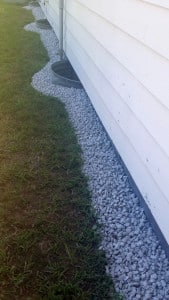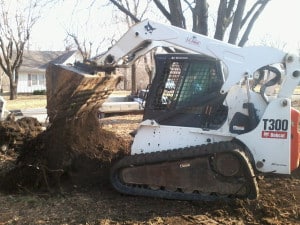Drainage Service Kansas City
Our crew installs drainage systems that move water away before it can cause damage. We put in French drains, surface drains, and downspout extensions that direct runoff where it belongs. We also regrade yards and tie sump discharge lines to daylight so water flows off the property instead of soaking back in. From small wet spots to full yard flooding, we keep Kansas City homes dry and protected.
Why Kansas City Homes Need Better Drainage
Kansas City’s clay soil doesn’t drain well. When it rains, the soil swells and traps water around the house. During dry months, that same soil shrinks and pulls away, leaving gaps where water can collect again. The constant cycle of swelling and shrinking weakens foundations and damages landscaping.
Types of Residential Drainage Systems We Install
Downspouts and Gutter Drains
Burying your gutters and sump pump drains so that they discharge away from your home can move thousands of gallons of water away from your foundation every time it rains.
Sump Pumps
Sump pumps are drainage systems installed to your home’s interior, often at the lowest point in your basement or crawl space. Sump pumps work by capturing water in what is referred to as a “sump pit,” then pumping the water out and away from your foundation. Sump pumps are crucial elements to other drainage systems, including basement perimeter drains.
Basin Drains

Basin drains can collect water in areas where water pools, such as landscape beds and places that are trapped between concrete and structures. Dry wells and catch basins are holes filled with gravel that hold water and allow it more time to soak into the ground, while box drains are grates connected to drainpipes and other systems that help move extra water. They may be helpful in dealing with a flooded walkway or as an alternative to using downspouts.
French Drains and Saturation Drains
French drains are also saturation drains and are commonly used to absorb water from the subsoil allowing for faster drying cycles, keeping the soil more absorbent for the next rain. French drains are often misused as a “fix all” and are often installed incorrectly, causing more problems for the property owner.

Curtain Drains
Our Curtain Drain is most suitable for the collection of water along a foundation or patio when it is not possible to create a grade that flows away from the structure.
Window Well Drain
A window well drain is essential for preventing your window well from filling with water and creating a basement leak. Window wells will often drain to your sump pump, though it is possible to drain your window well to daylight.
Grade Correction
Correcting the soil around your home may be as simple as adding a few yards of clean topsoil to build up the existing grade or be more complex like cutting out the existing soil in order to create proper fall and keep water flowing away from a structure.
Swales/Dry Creek Beds

Many times cutting a swale or dry creek bed near the house is the easiest and most economical way of controlling surface water, by changing the grade around a structure we can control how the water will flow in or around your property. The average home will need to have some sort of grade correction every six years as part of its normal maintenance.
A dry creek bed is a ditch covered in rocks that mimics the look of natural creek beds. They’re usually viewed as a more attractive drainage ditch option, and they’re helpful on properties dealing with a lot of fast-moving water, such as areas that experience flash floods. A swale, on the other hand, is a ditch that is covered in turf or other water-loving vegetation. The only catch with swales is that they can be susceptible to erosion if the water is too fast-moving.
Other Services We Offer
Foundation Repair
If poor drainage has already caused settlement or cracking, we provide foundation repair using piers, braces, and anchors to stabilize and lift the structure.
Waterproofing Service
We also install interior and exterior waterproofing systems that keep water from reaching your basement or crawl space. Combined with proper drainage, these systems keep your home dry year-round.
Concrete Contractor
As a concrete contractor, we replace and regrade concrete that has sunk or tilted toward the house. Driveways, patios, and walkways are reshaped to push water away from your home.
Signs You Need Drainage Repair
- Standing water near the foundation after rain
- Soggy or soft spots in the yard
- Downspouts draining right next to the house
- Water entering the basement or crawl space
- Erosion or washed-out soil near patios and steps
- Mold or musty smells inside the basement
If you’re noticing any of these signs, your yard or foundation may already be taking on water. Fixing drainage early helps prevent costly structural or waterproofing repairs later.
Our Drainage System Installation Process
At Foundation 1, we take a careful and proven approach to every basement drainage project in Kansas City. Our goal is to ensure your system is designed, installed, and tested to protect your foundation for years to come. Here’s how our process works:
1. Inspect
We start with a full property inspection, checking grading, gutters, downspouts, and water flow patterns around your foundation. This helps us identify problem areas and choose the right drainage solution for your home — whether it’s a French drain, curtain drain, or basin drain.
2. Explain
After the inspection, we walk you through what we found. Using photos and simple notes, we explain where the water is coming from and what’s causing the issue, so you know exactly what’s happening and why.
3. Plan
Our team designs a custom drainage plan based on your property layout, soil conditions, and budget. We prepare a detailed estimate and ensure all plans comply with local regulations and best practices.
4. Fix
Once approved, our crew installs the drainage system, adjusts grading as needed, and tests water flow to confirm everything is working properly. Every step is completed with precision and care to ensure long-term protection.
5. Follow Up
After installation, we revisit the site following a rainfall to review performance. If adjustments are needed, we make them right away to ensure your system keeps your basement dry and your foundation strong.
Why Kansas City Homeowners Choose Us
- Local Kansas City crew with years of experience
- Honest pricing and clear recommendations
- Work designed for local soil and weather
- Clean, careful installation on every job
- Real warranties on drainage and waterproofing systems
- Options for any size yard or home
We don’t sell one-size-fits-all solutions. We fix the cause of the problem so you don’t have to deal with it again.
Ready to Talk?
If you searched for drainage service Kansas City, you’re in the right place. We install, repair, and maintain drainage systems that protect your foundation and yard from water damage. Call or message us today to schedule your free inspection.
Get a free inspection and same-day plan.
Tell us where the water is pooling, and we’ll handle the rest.
FAQs
Is my home’s grade really that important?
Yes it is! So much so that international building code calls for a 6” drop in the first 10 feet away from the home. Fixing grade is not fun, but something homeowners can easily do. Spending a few dollars (or hours) on basement drainage systens for your Kansas City home can save thousands of dollars on expensive foundation repairs down the road.
How often should I monitor and maintain my grade?
How important is a properly functioning gutter system?
So this thing with cleaning leaves out of the gutter is important too?
My neighbor’s drainage systems pour right onto my property. Is this a big deal?
How far out from my home should I make sure the water goes?
We always suggest at least 10 feet. The simple bases to put at the base of your gutter downspouts is not sufficient.
What is a Curtain Drain?
Curtain Drain is designed to help divert water. Typically, it will involve digging a trench with the specific goal of moving water from one part of your yard to another. A waterproof liner is put inside the trench, along with a perforated pipe which will help collect the water and transport it. The trench is then filled with gravel so the surface water can reach the pipe.
